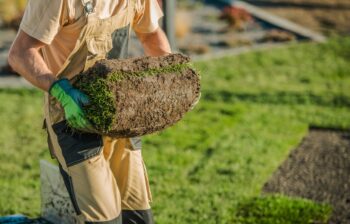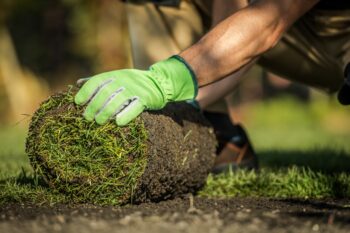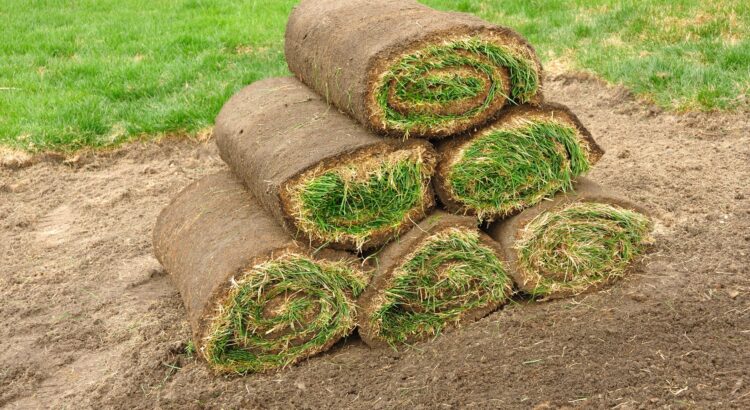As the leaves start changing colors and the air becomes crisp, many homeowners think it’s time to hang up their gardening gloves until spring. However, fall is an ideal season for planting sod and creating a lush, green oasis right in your own backyard.
In this article, we’ll explore the beneficial reasons for laying sod in the fall and highlight important factors to consider when installing sod during this season.

Beneficial Reasons to Lay Sod in Fall
Ideal Weather Conditions: Fall offers milder temperatures and more consistent rainfall compared to the scorching heat of summer or the freezing cold of winter. These favorable weather conditions create the perfect environment for newly laid sod to establish strong root systems.
Less Watering and Maintenance: In fall, cooler temperatures and increased precipitation reduce the need for frequent watering. As the sod takes root, it requires less attention and watering, allowing homeowners to spend less time on maintenance and more time enjoying their beautiful lawn. Read some of our sod watering tips and special care instructions.
Faster Establishment: Sod laid in the fall benefits from the warm soil, which promotes quicker and stronger root growth. As the roots establish themselves before winter sets in, the sod will have a head start in the spring, resulting in a healthier and more resilient lawn.
Weeds and Disease Control: Fall is a season when weed growth begins to slow down, giving sod a better chance to establish itself without competition. Additionally, many lawn diseases are less active during the cooler temperatures of fall, reducing the risk of sod damage or infections.
Contact us today and hire us to install your sod for you. Go to our sod installation service page.
Factors to Know About Installing Sod in Fall

Timing is Key: The timing of sod installation is crucial in the fall. Aim to lay the sod at least four to six weeks before the first hard frost. This gives the sod sufficient time to establish roots before winter arrives. Be mindful of local climate and frost dates when planning your sod installation.
Soil Preparation: Proper soil preparation is essential for successful sod installation. Clear the area of debris, rocks, and weeds. Loosen the soil and amend it with organic matter to ensure good drainage and nutrient availability for the sod’s roots.
Laying the Sod: Start laying the sod along straight edges, such as walkways, driveways, or property boundaries. Stagger the sod pieces in a brick-like pattern, pressing them firmly into the soil to eliminate air pockets. Use a sharp knife or shears to trim sod pieces to fit irregular areas.
Watering and Maintenance: After installation, water the sod thoroughly to ensure deep root penetration. Gradually reduce watering frequency as the sod establishes itself. Avoid over-watering, as it can lead to shallow root formation and susceptibility to winter damage. Regularly check for signs of pests, diseases, or weed growth and address them promptly.
Winter Protection: To protect the newly installed sod from extreme temperatures and potential sod heaving, consider covering the lawn with a light layer of mulch or straw once the ground starts to freeze. This helps insulate the sod and maintain more stable soil temperatures throughout the winter.
Keep your sod weed free and looking good. Head over to our weed control service page to learn how we can help.

Best Types of Turf for North Texas
When it comes to selecting the perfect turf for your North Texas lawn, it’s essential to choose a variety that can withstand the region’s unique climate and environmental conditions.
Fortunately, there are several top-performing turfgrass options that thrive in North Texas’ hot summers and unpredictable winter weather.
Whether you’re looking for a lush, green lawn for your family to enjoy or a low-maintenance option that saves on water usage, we’ve got you covered. Let’s explore some of the best types of turf for North Texas.
Bermuda Grass: Known for its exceptional heat and drought tolerance, Bermuda Grass is a popular choice for North Texas lawns. This warm-season grass is well-suited to the region’s long, hot summers and can withstand heavy foot traffic. Bermuda Grass requires full sun exposure and thrives in well-drained soils.
St. Augustine Grass: St. Augustine Grass is another warm-season grass that performs well in North Texas. It offers good shade tolerance, making it a smart choice for areas with mature trees. St. Augustine Grass has a beautiful medium to dark green color and creates a thick carpet-like appearance. It prefers partial shade and requires regular watering.
Zoysia Grass: Zoysia Grass is a warm-season grass that offers exceptional durability and a dense, attractive turf. It exhibits excellent drought resistance and heat tolerance, making it well-suited to North Texas’ challenging climate. Zoysia Grass requires full sun to partial shade and has a slower growth rate, resulting in fewer mowing requirements.
Wrapping Up
By laying sod in the fall, you can revive a tired lawn or create a beautiful new landscape in time for the following spring. With the ideal weather conditions, faster establishment, and reduced maintenance requirements, fall allows you to enjoy a thriving, vibrant lawn year-round.
Ensure you follow proper installation techniques, pay attention to soil preparation, and provide adequate care to ensure the success of your fall sod project.
When selecting the best turf for your North Texas lawn, consider factors such as the desired appearance, maintenance requirements, shade tolerance, and overall environmental adaptability.
Consulting with a local expert or Turfgrass professional can provide valuable insights and help you make an informed decision based on your specific needs and the unique characteristics of your lawn.
By choosing the right turfgrass variety, you can create a beautiful, resilient lawn that will thrive throughout the seasons and withstand North Texas’ challenging conditions.




